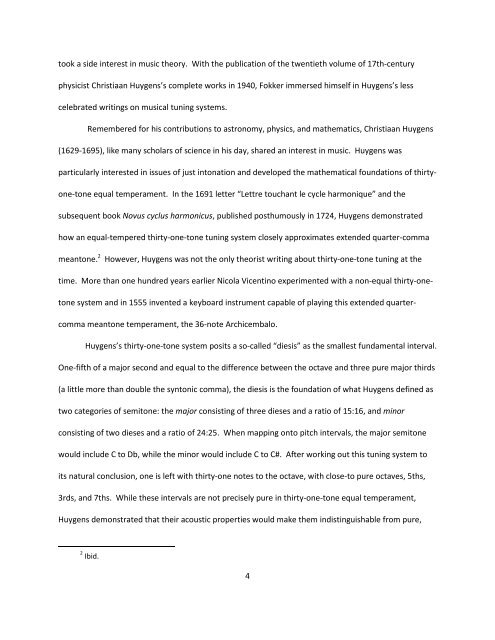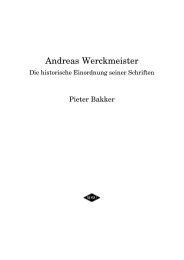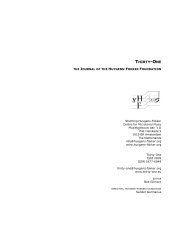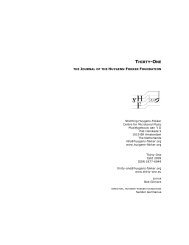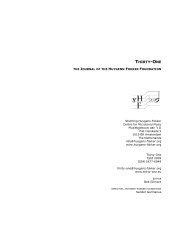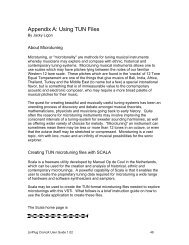Recent Organ Design Innovations and the 21st-century - Stichting ...
Recent Organ Design Innovations and the 21st-century - Stichting ...
Recent Organ Design Innovations and the 21st-century - Stichting ...
Create successful ePaper yourself
Turn your PDF publications into a flip-book with our unique Google optimized e-Paper software.
took a side interest in music <strong>the</strong>ory. With <strong>the</strong> publication of <strong>the</strong> twentieth volume of 17th-<strong>century</strong><br />
physicist Christiaan Huygens’s complete works in 1940, Fokker immersed himself in Huygens’s less<br />
celebrated writings on musical tuning systems.<br />
Remembered for his contributions to astronomy, physics, <strong>and</strong> ma<strong>the</strong>matics, Christiaan Huygens<br />
(1629-1695), like many scholars of science in his day, shared an interest in music. Huygens was<br />
particularly interested in issues of just intonation <strong>and</strong> developed <strong>the</strong> ma<strong>the</strong>matical foundations of thirty-<br />
one-tone equal temperament. In <strong>the</strong> 1691 letter “Lettre touchant le cycle harmonique” <strong>and</strong> <strong>the</strong><br />
subsequent book Novus cyclus harmonicus, published posthumously in 1724, Huygens demonstrated<br />
how an equal-tempered thirty-one-tone tuning system closely approximates extended quarter-comma<br />
meantone. 2 However, Huygens was not <strong>the</strong> only <strong>the</strong>orist writing about thirty-one-tone tuning at <strong>the</strong><br />
time. More than one hundred years earlier Nicola Vicentino experimented with a non-equal thirty-one-<br />
tone system <strong>and</strong> in 1555 invented a keyboard instrument capable of playing this extended quarter-<br />
comma meantone temperament, <strong>the</strong> 36-note Archicembalo.<br />
Huygens’s thirty-one-tone system posits a so-called “diesis” as <strong>the</strong> smallest fundamental interval.<br />
One-fifth of a major second <strong>and</strong> equal to <strong>the</strong> difference between <strong>the</strong> octave <strong>and</strong> three pure major thirds<br />
(a little more than double <strong>the</strong> syntonic comma), <strong>the</strong> diesis is <strong>the</strong> foundation of what Huygens defined as<br />
two categories of semitone: <strong>the</strong> major consisting of three dieses <strong>and</strong> a ratio of 15:16, <strong>and</strong> minor<br />
consisting of two dieses <strong>and</strong> a ratio of 24:25. When mapping onto pitch intervals, <strong>the</strong> major semitone<br />
would include C to Db, while <strong>the</strong> minor would include C to C#. After working out this tuning system to<br />
its natural conclusion, one is left with thirty-one notes to <strong>the</strong> octave, with close-to pure octaves, 5ths,<br />
3rds, <strong>and</strong> 7ths. While <strong>the</strong>se intervals are not precisely pure in thirty-one-tone equal temperament,<br />
Huygens demonstrated that <strong>the</strong>ir acoustic properties would make <strong>the</strong>m indistinguishable from pure,<br />
2 Ibid.<br />
4


